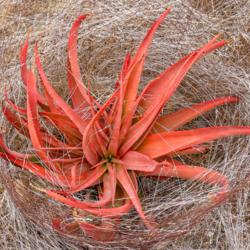That was really informative and helpful, Thijs.

My experience is almost exclusively with the aloe mite (my one case of agave mite was history as soon as I saw it).
I agree about the seeming futility of "curing" a mite-infested plant some times. After its second case of aloe mite, I will remove a plant for good. That's what happened with Hercules, and striata, and a maculate aloe. I actually didn't wait for a second time with nobilis and spinosissima. All those names are worth remembering in association with this garden pest because they're frequent victims. Not all aloes are equally susceptible, fortunately.
Sometimes (and often, in the places where aloes are native) aloe mites will only affect an inflorescence. I think they travel via the wind and via wings from there to other plants. It's to their advantage to get up high and fly free. You can amputate the inflorescence early and all visible symptoms will disappear until the next year, when another inflorescence comes out looking fishy. Aloe arborescens commonly does this.
On to more lively and colorful topics, here's a nice little dwarf that's about to put up 5 inflorescences.

I grew out seedlings from last year's flowers... really really slow but I think the plant may be self fertile. From what I have seen the seasonal growth pattern with this plant (a winter grower/summer slower) is pretty extreme, even with baby seedlings.






